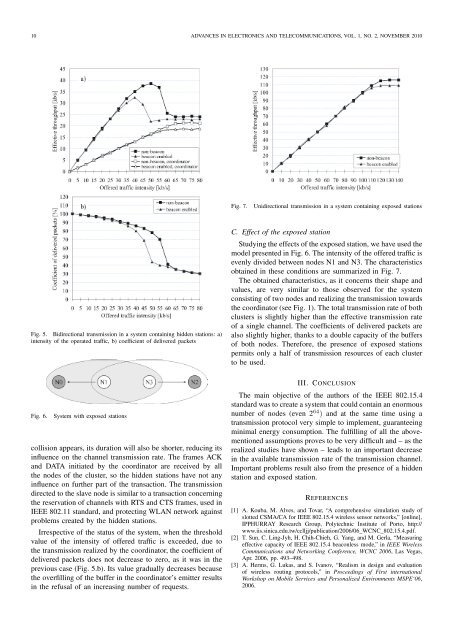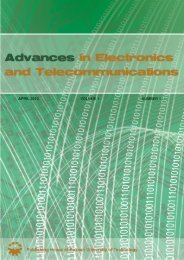november 2010 volume 1 number 2 - Advances in Electronics and ...
november 2010 volume 1 number 2 - Advances in Electronics and ...
november 2010 volume 1 number 2 - Advances in Electronics and ...
Create successful ePaper yourself
Turn your PDF publications into a flip-book with our unique Google optimized e-Paper software.
10 ADVANCES IN ELECTRONICS AND TELECOMMUNICATIONS, VOL. 1, NO. 2, NOVEMBER <strong>2010</strong><br />
Fig. 5. Bidirectional transmission <strong>in</strong> a system conta<strong>in</strong><strong>in</strong>g hidden stations: a)<br />
<strong>in</strong>tensity of the operated traffic, b) coefficient of delivered packets<br />
Fig. 6. System with exposed stations<br />
collision appears, its duration will also be shorter, reduc<strong>in</strong>g its<br />
<strong>in</strong>fluence on the channel transmission rate. The frames ACK<br />
<strong>and</strong> DATA <strong>in</strong>itiated by the coord<strong>in</strong>ator are received by all<br />
the nodes of the cluster, so the hidden stations have not any<br />
<strong>in</strong>fluence on further part of the transaction. The transmission<br />
directedtotheslave nodeis similarto atransactionconcern<strong>in</strong>g<br />
the reservation of channels with RTS <strong>and</strong> CTS frames, used <strong>in</strong><br />
IEEE 802.11 st<strong>and</strong>ard, <strong>and</strong> protect<strong>in</strong>g WLAN network aga<strong>in</strong>st<br />
problems created by the hidden stations.<br />
Irrespective of the status of the system, when the threshold<br />
value of the <strong>in</strong>tensity of offered traffic is exceeded, due to<br />
the transmission realized by the coord<strong>in</strong>ator, the coefficient of<br />
delivered packets does not decrease to zero, as it was <strong>in</strong> the<br />
previous case (Fig. 5.b). Its value gradually decreases because<br />
the overfill<strong>in</strong>g of the buffer <strong>in</strong> the coord<strong>in</strong>ator’s emitter results<br />
<strong>in</strong> the refusal of an <strong>in</strong>creas<strong>in</strong>g <strong>number</strong> of requests.<br />
Fig. 7. Unidirectional transmission <strong>in</strong> a system conta<strong>in</strong><strong>in</strong>g exposed stations<br />
C. Effect of the exposed station<br />
Study<strong>in</strong>gtheeffectsoftheexposedstation,wehaveusedthe<br />
modelpresented<strong>in</strong> Fig. 6.The<strong>in</strong>tensity ofthe offeredtraffic is<br />
evenly divided between nodes N1 <strong>and</strong> N3. The characteristics<br />
obta<strong>in</strong>ed <strong>in</strong> these conditions are summarized <strong>in</strong> Fig. 7.<br />
The obta<strong>in</strong>ed characteristics, as it concerns their shape <strong>and</strong><br />
values, are very similar to those observed for the system<br />
consist<strong>in</strong>g of two nodes<strong>and</strong> realiz<strong>in</strong>g the transmission towards<br />
the coord<strong>in</strong>ator(see Fig. 1). The total transmissionrate of both<br />
clusters is slightly higher than the effective transmission rate<br />
of a s<strong>in</strong>gle channel. The coefficients of delivered packets are<br />
also slightly higher, thanks to a double capacity of the buffers<br />
of both nodes. Therefore, the presence of exposed stations<br />
permits only a half of transmission resources of each cluster<br />
to be used.<br />
III. CONCLUSION<br />
The ma<strong>in</strong> objective of the authors of the IEEE 802.15.4<br />
st<strong>and</strong>ardwastocreateasystemthatcouldconta<strong>in</strong>anenormous<br />
<strong>number</strong> of nodes (even 2 64 ) <strong>and</strong> at the same time us<strong>in</strong>g a<br />
transmission protocol very simple to implement, guarantee<strong>in</strong>g<br />
m<strong>in</strong>imal energy consumption. The fulfill<strong>in</strong>g of all the abovementioned<br />
assumptionsprovesto be very difficult <strong>and</strong> – as the<br />
realized studies have shown – leads to an important decrease<br />
<strong>in</strong> the available transmission rate of the transmission channel.<br />
Important problems result also from the presence of a hidden<br />
station <strong>and</strong> exposed station.<br />
REFERENCES<br />
[1] A. Kouba, M. Alves, <strong>and</strong> Tovar, “A comprehensive simulation study of<br />
slotted CSMA/CA for IEEE 802.15.4 wireless sensor networks,” [onl<strong>in</strong>e],<br />
IPPHURRAY Research Group, Polytechnic Institute of Porto, http://<br />
www.iis.s<strong>in</strong>ica.edu.tw/cclljj/publication/2006/06_WCNC_802.15.4.pdf.<br />
[2] T. Sun, C. L<strong>in</strong>g-Jyh, H. Chih-Chieh, G. Yang, <strong>and</strong> M. Gerla, “Measur<strong>in</strong>g<br />
effective capacity of IEEE 802.15.4 beaconless mode,” <strong>in</strong> IEEE Wireless<br />
Communications <strong>and</strong> Network<strong>in</strong>g Conference, WCNC 2006, Las Vegas,<br />
Apr. 2006, pp. 493–498.<br />
[3] A. Herms, G. Lukas, <strong>and</strong> S. Ivanov, “Realism <strong>in</strong> design <strong>and</strong> evaluation<br />
of wireless rout<strong>in</strong>g protocols,” <strong>in</strong> Proceed<strong>in</strong>gs of First <strong>in</strong>ternational<br />
Workshop on Mobile Services <strong>and</strong> Personalized Environments MSPE‘06,<br />
2006.







